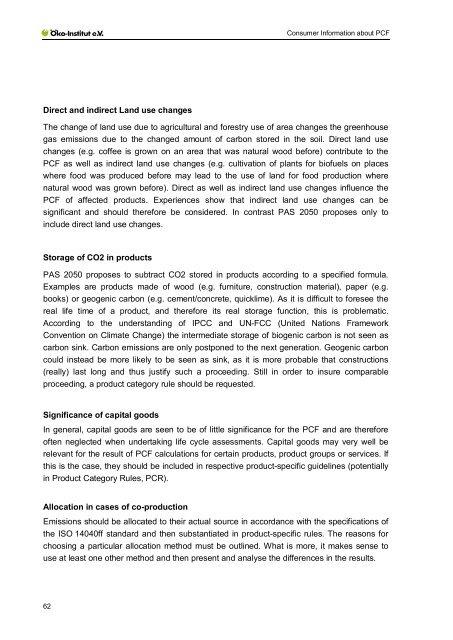Requirements on Consumer Information about Product ... - ANEC
Requirements on Consumer Information about Product ... - ANEC
Requirements on Consumer Information about Product ... - ANEC
You also want an ePaper? Increase the reach of your titles
YUMPU automatically turns print PDFs into web optimized ePapers that Google loves.
C<strong>on</strong>sumer Informati<strong>on</strong> <strong>about</strong> PCF<br />
Direct and indirect Land use changes<br />
The change of land use due to agricultural and forestry use of area changes the greenhouse<br />
gas emissi<strong>on</strong>s due to the changed amount of carb<strong>on</strong> stored in the soil. Direct land use<br />
changes (e.g. coffee is grown <strong>on</strong> an area that was natural wood before) c<strong>on</strong>tribute to the<br />
PCF as well as indirect land use changes (e.g. cultivati<strong>on</strong> of plants for biofuels <strong>on</strong> places<br />
where food was produced before may lead to the use of land for food producti<strong>on</strong> where<br />
natural wood was grown before). Direct as well as indirect land use changes influence the<br />
PCF of affected products. Experiences show that indirect land use changes can be<br />
significant and should therefore be c<strong>on</strong>sidered. In c<strong>on</strong>trast PAS 2050 proposes <strong>on</strong>ly to<br />
include direct land use changes.<br />
Storage of CO2 in products<br />
PAS 2050 proposes to subtract CO2 stored in products according to a specified formula.<br />
Examples are products made of wood (e.g. furniture, c<strong>on</strong>structi<strong>on</strong> material), paper (e.g.<br />
books) or geogenic carb<strong>on</strong> (e.g. cement/c<strong>on</strong>crete, quicklime). As it is difficult to foresee the<br />
real life time of a product, and therefore its real storage functi<strong>on</strong>, this is problematic.<br />
According to the understanding of IPCC and UN-FCC (United Nati<strong>on</strong>s Framework<br />
C<strong>on</strong>venti<strong>on</strong> <strong>on</strong> Climate Change) the intermediate storage of biogenic carb<strong>on</strong> is not seen as<br />
carb<strong>on</strong> sink. Carb<strong>on</strong> emissi<strong>on</strong>s are <strong>on</strong>ly postp<strong>on</strong>ed to the next generati<strong>on</strong>. Geogenic carb<strong>on</strong><br />
could instead be more likely to be seen as sink, as it is more probable that c<strong>on</strong>structi<strong>on</strong>s<br />
(really) last l<strong>on</strong>g and thus justify such a proceeding. Still in order to insure comparable<br />
proceeding, a product category rule should be requested.<br />
Significance of capital goods<br />
In general, capital goods are seen to be of little significance for the PCF and are therefore<br />
often neglected when undertaking life cycle assessments. Capital goods may very well be<br />
relevant for the result of PCF calculati<strong>on</strong>s for certain products, product groups or services. If<br />
this is the case, they should be included in respective product-specific guidelines (potentially<br />
in <strong>Product</strong> Category Rules, PCR).<br />
Allocati<strong>on</strong> in cases of co-producti<strong>on</strong><br />
Emissi<strong>on</strong>s should be allocated to their actual source in accordance with the specificati<strong>on</strong>s of<br />
the ISO 14040ff standard and then substantiated in product-specific rules. The reas<strong>on</strong>s for<br />
choosing a particular allocati<strong>on</strong> method must be outlined. What is more, it makes sense to<br />
use at least <strong>on</strong>e other method and then present and analyse the differences in the results.<br />
62
















